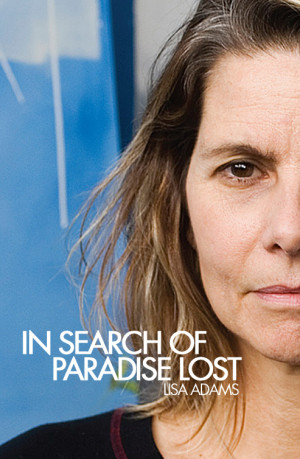
The Santa Fe Art Colony lies buried beneath a layer of concrete. Just like Pompeii lived in the shadow of Mt. Vesuvius, the colony is eclipsed by a cement factory that force-feeds soot into the air. The quarry yard of the factory is out of sight and out of mind thanks to a chain-linked fence separating the world of harmful commerce from a peaceful artist commune.
The colony, flanked by burgundy bungalows and lined with potted plants and flowers, is what Tyler Durden’s house could have looked like on Paper Street if he and his posse from Project Mayhem had done a little yard work. A Proustian conundrum exists here, searching for lost time in the face of a paradise that is rapidly decaying.
Lisa Adams, a resident of Santa Fe, leads us into her shared studio space where industrial strength poster board, held together by clear packing tape, divides the room. She wears Levi jeans with paint so deeply embedded in the memory of the cotton fibers that no rinse cycle will ever clean them. Some of the works for her January upcoming show The Future of Paradise Past at the Lawrence Asher Gallery hang on the wall of her studio, waiting for their final inspection.
Adams explains that the narrative of her show is, “almost nether-world Ground Zero, less than an Edenic kind of world. So it’s sort of almost like,” she pauses and adds, “apocalyptic might be a little too extreme but it’s twisted enough so you can kind of get that life persists, the life is driven to persist but it somehow is thwarted.” Los Angeles, especially the Santa Fe art colony is an urban anomaly that rectifies Adam’s theme of nature competing with industry. The graffiti aesthetics adopted for We Destroyed the Things We Loved, suggests the destruction happens inside the studio and outside on the streets.
We Destroyed the Things We Loved presents the duality of aesthetics encountered when viewing industry versus nature. The painting depicts an electric blue iceberg, partially fractured, floating in crisp Arctic water. A web of vines arcs over the ice and conceals the tip of the iceberg. Large bubble letters outlined with black spray paint interrupt the natural movement of the iceberg and make it a static image hidden behind graffiti. The lettering looked familiar to me because a roach coach turned in front of me the same day I received a copy of the painting. The graffiti style, similar to the lettering on the truck, reflected an air of authentic LA – one that showcases Adams’ deep connection to the fabric of the city in which she has spent her entire artistic career.
In discussing the aforementioned painting Adams reveals that, “on a lot of those roach coaches…you’ve got this what I would call kinda high amateur level painting and then you’ve got this tag on it and it’s sort of awesome…” As Adams reminiscences about spray painting over the iceberg, she continues, “I was so fucked up trying to put the tagging on it.” While she speaks to me she paints in mid-air, her right hand coils as if it was holding a paintbrush as she transforms dead space into a canvas.
Adams’ The Future of Paradise Past insists that nature is ever looming. The city is a palimpsest; years of tagging and decay conceal a narrative driven by the notion that urbanity is most unexpected. Just like a flower growing up from the concrete depths of a splintered sidewalk, or the vines you often encounter when passing beneath a freeway, what we uncover are artifacts of a natural history. Adams describes this as the, “combative idea between the nature that wants to kind of take over.” The painted vines arching around the iceberg in, We Destroyed the Things We Loved, reflect Adams’ fascination with something growing from nothing. They remind her of “vines just dangling down into mid-air, [that] you don’t even know how they got there.”
Working in near isolation, Lisa Adams constructs pseudo-utopian paintings while concrete swallows the world beyond her wall of windows. Despite this resentment of her urban environment, Adams is thankful for places like the Santa Fe Art Colony, a true example of a flower rising up from the depths of an urban jungle. “I’m not rich,” she explains, but “the art world in some way has provided me a way to experience and to express what I think are the two things that are most important to me.” 28 years of working in LA as a painter, teacher, curator, and public artist inextricably binds Lisa Adams to the urban tapestry of a city where something always seems to grow from nothing.
A. Moret is a freelance writer based in Los Angeles. Her work expresses concern for art criticism, theory, history and institutional critique.
